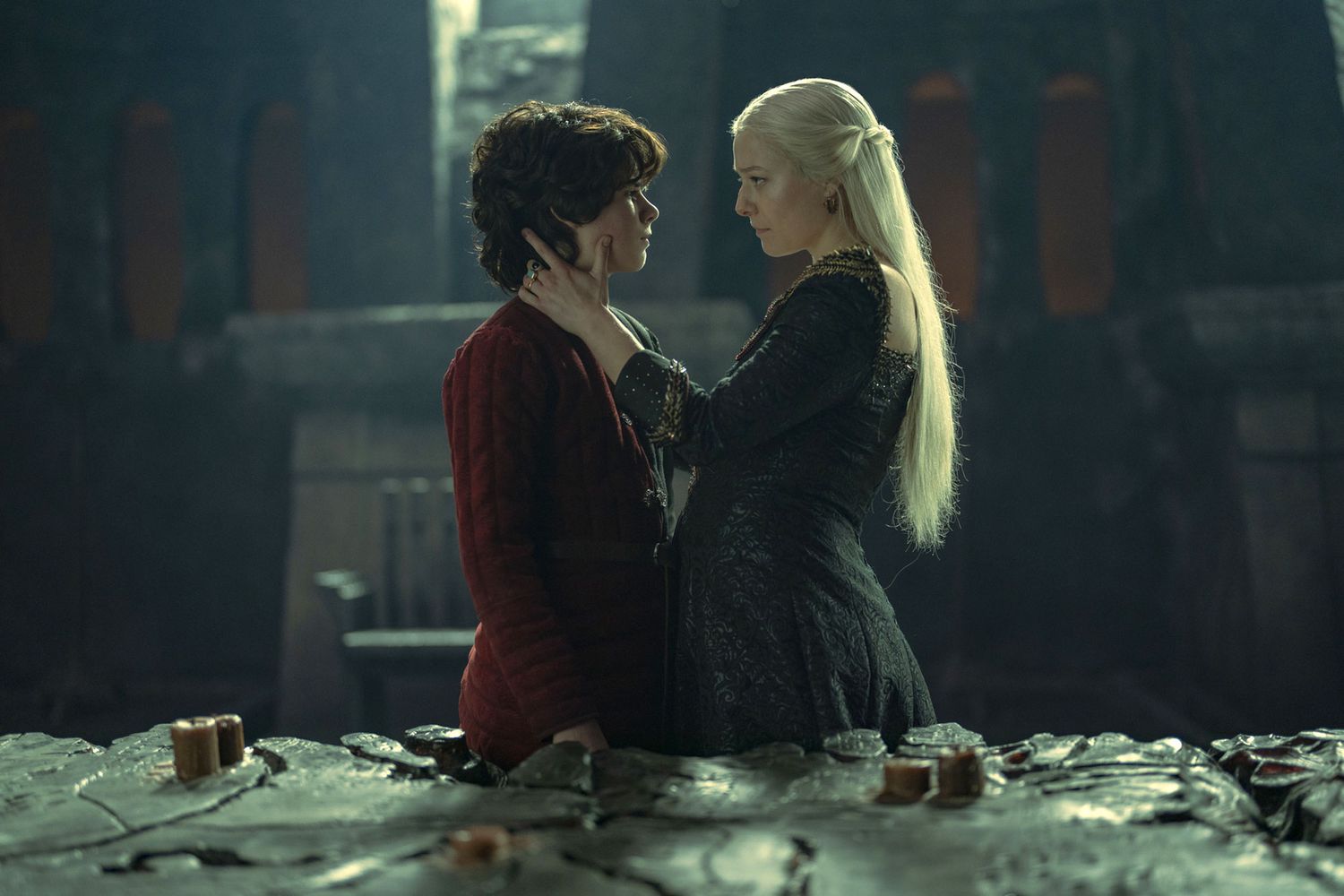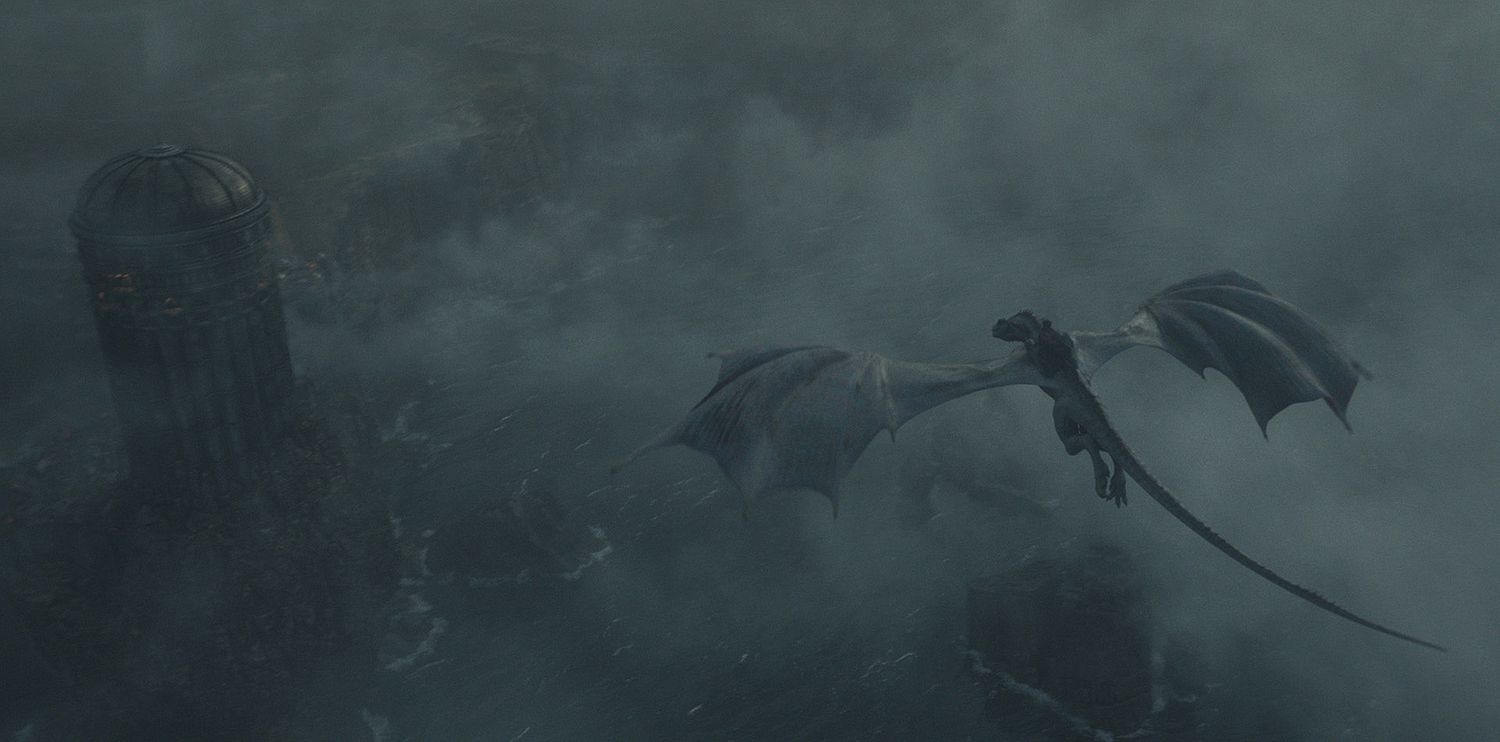House of the Dragon creator calls season finale death ‘another major point of no return’
House of the Dragon‘s first season ends with a literal dance between dragons.
In George R.R. Martin’s book Fire and Blood, there are many moments one could argue as pushing the Targaryen conflict towards all-out war. But Ryan Condal, who co-created HBO’s Game of Thrones prequel with Martin and spearheaded season 1 with co-showrunner Miguel Sapochnik, feels, “The thing that really pushes it over the edge, because it now involves people outside of just House Targaryen, is this act of war that happens over Storm’s End.” That was where he wanted to close the season, adding, “It was fairly apparent right from the outset that was where it had to be.”
After the Greens steal the throne for Aegon II Targaryen (Tom Glynn-Carney) in House of the Dragon‘s penultimate episode, the Blacks make their counter moves. Rhaenyra Targaryen (Emma D’Arcy) is crowned Queen of Westeros at Dragonstone, wearing her father’s crown, and is forced to take stock of her allies. She sends envoys to various lords to remind them of their oaths of fealty that they made to her when she was younger. That entails sending her son, Lucerys “Luke” Velaryon (Elliot Grihault) to Storm’s End to secure the support of Lord Borros Baratheon (Roger Evans).
| CREDIT: OLLIE UPTON / HBO
Only Luke is too late. The boy finds Aemond “One-Eye” Targaryen (Ewan Mitchell) has beaten him there. And Aemond even offered to sweeten the deal with pacts of marriage to bind the crown with Borros’ daughters by blood. Borros turns Luke away, but not before Aemond tries to take out Luke’s eye as age-old retribution for when they were tikes. “Not in my home,” Borros rumbles, which leads to Aemond mounting Vhagar, the largest dragon in the world, to torment Luke, riding the much smaller Arrax, in the skies above the castle.
An addition to the show that’s not specified in the books, both boys lose control of their steeds. Arrax, feeling threatened, breathes fire at Vhagar, who then attacks Luke and his mount, leading Rhaenyra’s son to tumble into the sea to his death.
“The war is called the Dance of the Dragons, and this is the first dragon fight that has happened since Old Valyria,” Condal explains in an interview with EW. “So the fact that is the first shot, to me, made it an almost necessary end point for the first season. Aegon sees Rhaenyra’s crown and throne claim here, but now the stakes have gone up to this point. What’s going to happen next? It’s such a great precipice to leave everybody on going into the second season.”
Condal refers to this sequence as “a beautiful microcosm of the larger conflict between the Blacks and the Greens.” In writing the series, once the team designed the dragons and the writers room realized just how much bigger Vhagar was than Arrax, “It became less of a fight and more of a chase,” says the co-creator. He references Steven Spielberg’s 1971 movie Duel in saying, “A sequence where a boy is being terrorized by the largest dragon in existence. It’s an escape.”
“We wanted it to be interesting, complex… not just a foregone conclusion,” Condal continues. “We’ve set up Aemond as a human being who’s had a tough life and has been bullied and lost an eye in the process, but we’ve also set him up as somebody who’s smart and calculating. He’s somebody who’s capable of acting on impulse, but he doesn’t feel like somebody who would go out and commit straight murder without thinking about it.”
In the final shot of the season, a dialogue-less, score-fueled scene from composer Ramin Djawadi, Prince Daemon (Matt Smith) solemnly walks into the war room at Dragonstone to inform Rhaenyra that her son is dead. The queen turns to face the fireplace. Her knees begin to buckle. Her head drops down as she weeps for Luke, having only recently suffered the loss of her father and her stillborn daughter Visenya. Rhaenyra’s head then begins to rise — turns straight to camera. Her tear-stained despair is now a fiery rage.
Condal acknowledges Rhaenyra has changed a lot in this moment, but clarifies, “I don’t think it’s changed ultimately who the character is. It’s certainly changed her point of view and emotionality. It’s yet to be seen where she goes next, but certainly this is another major point of no return in the punch/counter punch of Alicent’s side and Rhaenyra’s side.”
| CREDIT: HBO
The takeaway from House of the Dragon season 1 is clear for Condal, the finale just makes it more apparent. Aemond, intending to taunt Luke, ends up killing him in a brutal manner. Rhaenyra, once commended by Princess Rhaenys Targaryen (Eve Best) for her hesitance to burn everything to the ground, now appears to be out for blood. A war-bound Daemon, as well, is seen choking Rhaenyra earlier in the finale for talking about prophecies instead of taking more forceful action, not knowing what her father told her as a teen.
Condal credits Smith for making Daemon, specifically, “incredibly fascinating, likable, charismatic, and alluring.” But book readers will recall Daemon, known as the Rogue Prince, described thusly: “There was not a man so admired, so beloved, and so reviled in all Westeros.” “He’s not the cowboy in the white hat,” Condal notes. “He’s a deeply wounded, complex, dark individual that is capable of doing some really great things. But Daemon is a prickly pear. He is a complex individual who has some real darkness and violence in him.”
The finale has echoes of something Martin himself said at the San Diego Comic-Con panel for House of the Dragon: there’s no one you’re really rooting for. “People that come to this show looking for black hats and white hats, and good guys and bad guys, and the person that I’m gonna root for and they’re never gonna do anything to make me question my loyalty to them, this is just not the show for that,” Condal adds. “This show is populated by deeply complex, human characters who are capable of good actions and bad actions and mistakes and moments of heroism and moments of monstrosity. They will do things that will frustrate the audience, but they are real people and real characters and they are not archetypes.”






